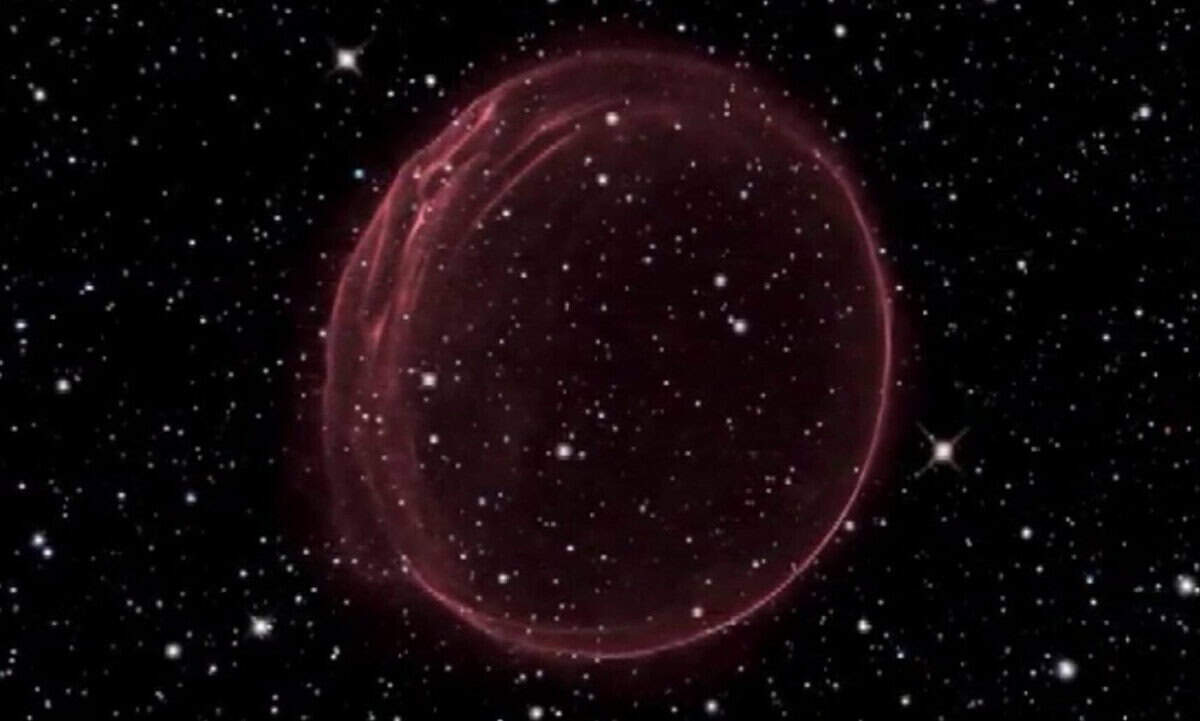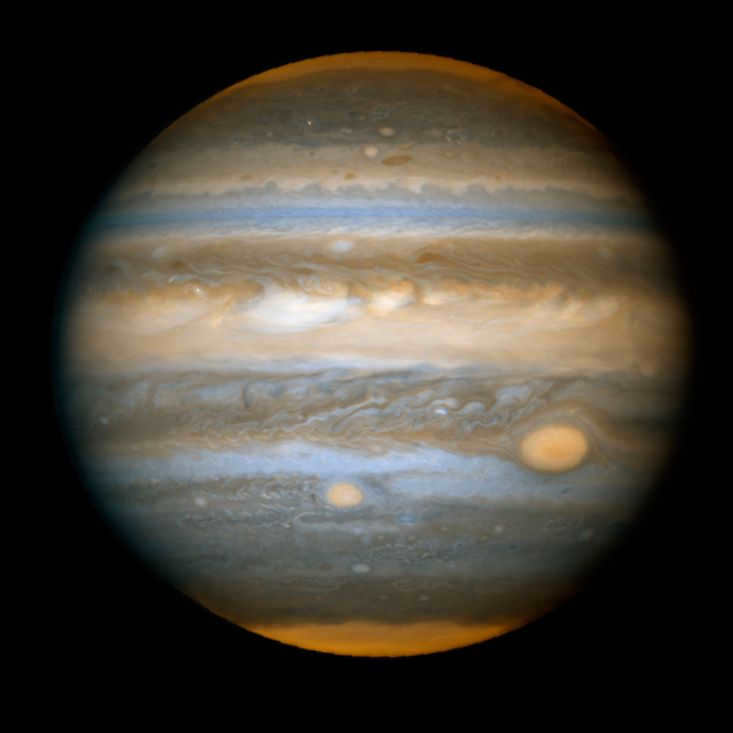
“Making reading a habit is an error,” explains Philip Marcus, a professor of mechanical engineering at the University of California, Berkeley, who specializes in computational physics, as we sip on our coffee at a local café. “You become too familiar with the subject matter. That’s how I became captivated by the intricacies of fluid dynamics.”
In 1978, Marcus began his postdoctoral fellowship at Cornell, focusing on numerical simulations of solar convection using spectral methods. However, he had a desire to study cosmic evolution and the general theory of relativity. Unfortunately, many people claimed they had never seen the results of GR in their entire lives, causing the field to become silent and leading GR experts to explore other areas.
During this time, Voyager 1 started transmitting close-range images of Jupiter back to Earth. Marcus would visit a special lab near the astrophysics building to relax and de-stress, where he would marvel at the Voyager photos of the Great Red Spot. This iconic storm had been observed since 1665, when Robert Hooke first spotted it. Marcus realized that very few astronomers had knowledge of fluid dynamics, which he possessed. This realization sparked his interest in conducting research on the topic.
He has not ceased his efforts ever since. At present, he possesses a wealth of knowledge regarding the most renowned tempest in the entire solar system. Displaying the physique of an avid mountain biker, he responds to my inquiries with animated gestures and occasional arm movements in an endeavor to elucidate his thoughts. He readily admits that his energy may occasionally result in clumsiness. “People tend to be wary of me,” he remarks. – “The moment I step foot into a laboratory, something invariably ends up broken.” Thankfully, he adds, “I have been extremely fortunate to have cultivated friendships with a select few experimentalists.”
What captures your attention about the massive crimson storm?
What is the origin of the BKP?
The BKP is believed to have originated in one of two ways. One possibility is that it was formed by an upward gas flow that reached the stratosphere and then wrapped around, creating the vortex. If this upward flow can reach a stable layer of the atmosphere, it can then propagate horizontally. In a rapidly rotating system like Jupiter, this horizontal propagation leads to the formation of the vortex. Another theory suggests that the instability of the jet stream in the atmosphere led to wave oscillations. As the amplitude of these waves increased, they eventually disintegrated into smaller vortices, which later merged to form the BKP.
What caused its appearance on Jupiter rather than any other location?
When flying over the ocean on Earth, it is easy to predict the location of islands below based on the presence of clouds. These topographical features tend to attract clouds. However, Jupiter is a completely different story. Unlike Earth, Jupiter does not have a solid surface except for its shallow core. It is primarily composed of liquid. This means that there are no variations in heat between continents and islands, and there are no mountain ranges to interrupt the wind patterns. Instead, Jupiter has a system of well-organized jet currents. These currents naturally create eddies, where opposing winds collide and rub against each other. It’s similar to a ball placed between two walls moving in opposite directions, causing the ball to spin. In the case of Jupiter, the opposite currents cause the air between them to spin and form vortices. These vortices have a strong resistance to anything that comes into contact with them. For example, if I were to create a whirlpool in a bathtub and slap it, it would disappear. However, if I were to simulate a similar phenomenon on Jupiter using the zonal winds and try to split it in two, it would quickly reassemble. This is why I view jet streams on Jupiter as fertile gardens for growing vortices.
I believe that the BKP has a height of 50-70 kilometers. Its width is approximately 26,000 kilometers. The BKP has a pancake-like shape. Similar to squeezing a tube of toothpaste, if pressure is applied to the center of the pancake, substances will be expelled from its sides, as well as from the top and bottom. Although there is high pressure in the center of the BKP, the gases do not escape horizontally from all directions due to the Coriolis force. Instead, they escape vertically from the top and bottom. The gases are prevented from escaping from the top and bottom by a dense cold cap of atmosphere that rests on top of the BCS. This extra density exerts a force that pushes the BKP gases downward. Additionally, there must be a warm buoyant atmospheric floor beneath the BKP, which prevents the high pressure in the center from pushing the gases down. This arrangement creates a balanced system.
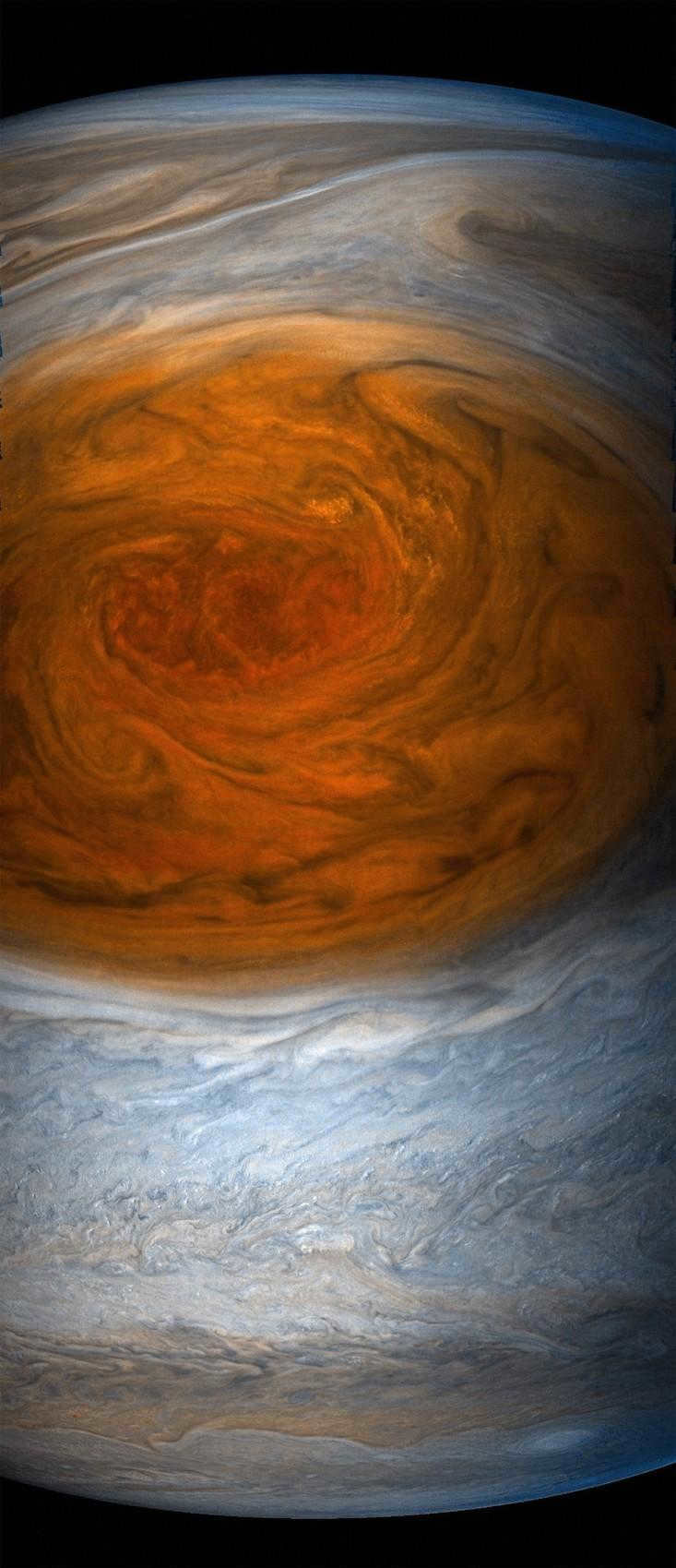
What prevents BKP from disintegrating due to friction?
Our common sense tells us that vortices cannot exist indefinitely, as they should eventually break apart due to friction. Friction can take various forms, and one potential factor that could dismantle the BKP, according to some theories, is the presence of Rossby waves. Rossby waves are a type of atmospheric wave that arises because the atmosphere is a rotating spherical shell rather than a rotating plane. They are commonly observed in the atmosphere and travel at relatively low speeds. Some believed that the BKP would start emitting Rossby waves, leading to a loss of energy. When unexpected events occur in the atmosphere, such as the collision of two vortices, Rossby waves are produced. However, typically once a vortex is formed, it ceases to emit Rossby waves, so there is currently no evidence suggesting that the emission of Rossby waves would destroy a BKP in a state of quasi-equilibrium.
What other factors could hinder its progress?
If we delve into the investigation of what can assault the BKP and dismantle it, we must contemplate not only the impact on kinetic energy caused by factors like friction; we must contemplate what ultimately proves to be more significant – what assails the potential energy. There exists a well-established culprit for potential energy leakage – it goes by the name of “radiant equilibrium”. If I were able to chill a specific portion of the Earth’s atmosphere, I could retrieve a stopwatch and inquire, “So, I am curious as to how much time it will take for this region to reheat and achieve radiative equilibrium with the encompassing atmosphere?” Alternatively, should I create a small hot spot somewhere, I might ponder, “How much time would elapse for equilibrium to be established through photon transfer and other factors, subsequent to which my hot spot would lose its temperature disparities?” According to calculations conducted by fellow scientists, we are aware that within the segment of the atmosphere housing the BKP, cold or hot patches vanish in roughly four and a half years – that is the duration it takes for particularly warm or cold patches to become utterly indistinguishable from their surroundings. Hence, we conducted an extensive array of numerical simulations, and if you input the warming or cooling effect into our computer model, it transpires that the BCP dissolves within four and a half years.
The average velocity of motion around this particular area is approximately 300 kilometers per hour. Jet streams, which also move at a similar speed, are believed to have negligible vertical velocities, estimated to be in the range of centimeters per hour. Consequently, these vertical winds are often disregarded. However, vertical air currents continually occur in significant portions of the atmosphere, suggesting they cannot be dismissed. We hypothesize that the BKP’s resistance to destruction is due to the heat transferred into the cold cap and released from the warm bottom, in an attempt to establish radiative equilibrium. Despite this radiative heat transfer, we believe the BKP manages to survive due to its minimal vertical velocity.
However, when the BKP dissipates, the initial pressure equilibrium is disturbed. This imbalance enables the elevated pressure in the center of the BKP to expel the gases upwards, passing through the relaxed cover. As the gases ascend, the wind cools down, providing fresh cold air to the cap, resulting in its cooling and increased weight. A similar sequence of events takes place at the bottom of the BKP, which helps to restore the warm bottom that is being targeted by thermal radiation.
Additionally, the gas that is moving in an upward direction through the vanishing cover is also being pushed outward towards the exterior of the BKP. Eventually, it ceases its upward movement and spreads out horizontally, covering an area that is significantly larger than the BKP itself. Subsequently, it changes direction and begins to move downward. This descending gas exerts pressure on the atoms and molecules of the surrounding atmosphere, causing them to lose some of their potential energy. Consequently, the gas completes its journey by returning to the center of the BKP. Along the way, it accumulates potential energy that is released from the atmosphere surrounding the BKP.
The BKP’s loss of energy through thermal radiation is balanced by the collection of this energy. When conducting a computer simulation, it is possible to measure the direction and strength of all the energies entering and leaving the BKP, and the entire energy budget fits together seamlessly. There is a significant release of potential energy into the surrounding atmosphere due to gas circulation, but this is not a problem because the Sun restores radiative equilibrium in that area and provides additional energy. Therefore, the ultimate source of energy that prevents the BKP from vanishing is the Sun.
Why is it important to study the atmosphere of a faraway planet?
In order to comprehend the functioning of Jupiters in other solar systems, one must first understand how Jupiter operates in our own solar system. Currently, there is a growing interest in discovering other Jupiters in different solar systems, as we speculate about the existence of other planets and the possibility of life on them. The process of examining planets that orbit other suns must begin somewhere, and making errors is an essential part of the scientific investigative process.
Hardware is adored by everyone. What NASA requires is another individual like Carl Sagan. Carl possessed the ability to persuade individuals to appreciate our findings on their own merit, not solely the devices that enabled those findings.
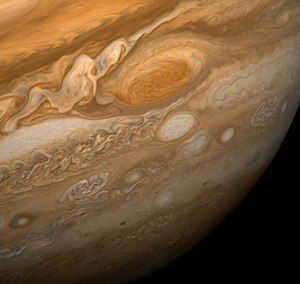
The BKP, also known as The Great Red Spot, is a well-known atmospheric formation located on the planet Jupiter. It has been observed for approximately 350 years and is considered to be the most prominent feature on the planet’s disk.
Key Features of the BKP
Giovanni Cassini discovered the BKP in 1665, while a similar detail was recorded by Robert Hooke in 1664. It was commonly believed by astronomers before the Voyager mission that the spot had a solid nature.
BKP is an enormous cyclone-anticyclone, with dimensions of 24-40 thousand kilometers in length and 12-14 thousand kilometers in width (significantly larger than the Earth). The size of the spot is constantly in flux, with a general trend towards reduction; a century ago, the BKP was approximately twice as large and significantly brighter (as evidenced by A. A. Belopolsky’s observations in the 1880s). Nonetheless, it remains the largest atmospheric vortex in the entire solar system.
The spot is situated around 22° south latitude and moves in parallel with the equator of the planet. Additionally, the gas within the BKP rotates in a counterclockwise direction with a period of rotation of roughly 6 Earth days. The wind speed within the spot exceeds 500 km/h.
The upper cloud layer of the BKP is located approximately 8 km above the surrounding clouds. The spot’s temperature is slightly cooler compared to the surrounding areas, while its central part is a few degrees warmer than the outer regions [1].
The exact cause of the BKP’s red color remains unclear. It is speculated that this hue may be attributed to chemical compounds, potentially including phosphorus.
In addition to the BKP, Jupiter also features other smaller “hurricane spots.” These spots can appear in white, brown, or red shades and have the potential to persist for decades, or possibly even longer. Although spots in Jupiter’s atmosphere have been observed in both the Southern and Northern Hemispheres, the ones that remain stable and endure for an extended period of time seem to be predominantly located in the Southern Hemisphere for unknown reasons.
The merger of three smaller white ovals that had been observed for 60 years before resulted in the formation of the Oval BA between 1998 and 2000. Initially, this new atmospheric formation appeared white to the naked eye, but in February 2006, it underwent a transformation and turned a reddish-brown color. One hypothesis suggests that when the hurricane remains at the same altitude as the general surface of the upper atmosphere, it maintains its white color. However, as its strength intensifies, the vortex ascends slightly above the overall cloud layer, where it is exposed to ultraviolet radiation from the Sun. This exposure chemically alters the color, giving it a reddish hue.
These gigantic “spot hurricanes” are not unique to Jupiter; they are also observed on other gas planets. For instance, the Great Dark Spot on Neptune is a well-known example.
Notes
References
The inaugural 3D depiction of Jupiter’s atmosphere Editorials Articles by Editors
The Juno spacecraft, which has been in orbit around the planet since 2016, has gathered the data. It has measured the profundity of the Great Red Spot for the very first time – surpassing 350 kilometers.
Based on the information from the Juno interplanetary station (Juna) launched in 2011, scientists have constructed the initial three-dimensional representation of Jupiter’s atmosphere, as reported on NASA’s official website.
Thanks to the “Juno” Microwave Radiometer MWR, scientists have been able to penetrate beneath Jupiter’s cloud layer and gauge the depth of the Great Red Spot – an immense anticyclone that astronomers have been observing since 1665.
It transpired that the tempest reaches a depth of 350-500 kilometers into the atmosphere – this lies beneath the point at which the water and ammonia of the Jupiterian atmosphere condense into dense clouds. Meanwhile, the zonal whirlwinds encircling the Great Red Spot reach even greater depths – nearly three thousand kilometers below.
The magnitude and dimensions of the Great Red Spot suggest that the density of atmospheric mass within the storm could potentially be discerned by instruments designed to investigate Jupiter’s gravitational field.
The Great Red Spot, with a diameter of approximately 16,000 kilometers, is described as a massive storm where winds continuously blow at a speed of 500 kilometers per hour. Yohai Caspi explained that if the Earth were placed within this storm, it would engulf the entire space station. Interestingly, the size of the Great Red Spot has been steadily decreasing over time, as its diameter initially measured 40-50 thousand kilometers.
Researchers have discovered a puzzling correlation between the rotation direction of vortices in Jupiter’s atmosphere and the temperature distribution. Vortices that rotate in the same direction as the planet exhibit warmer conditions at their upper regions and cooler conditions at their lower regions. Conversely, vortices that spin in the opposite direction experience colder temperatures at the top and warmer temperatures at the bottom.
Astronomers are still puzzled by the origins of Jupiter’s slender atmospheric belts – the white and reddish bands of clouds that are separated by powerful winds blowing in opposite directions. Juno’s findings suggest that ammonia gas may play a role in the formation of these belts, as it moves up and down in sync with the observed jet streams.
Juno’s sensors also successfully captured data on Jupiter’s polar regions, revealing the presence of massive cyclonic storms. Surprisingly, these atmospheric formations, totaling eight in the northern hemisphere and five in the southern hemisphere, remain incredibly stable and stationary.
The Great Red Spot is a phenomenon in Jupiter’s atmosphere that is both larger than Earth and capable of engulfing smaller storms. It is considered one of the most distinctive characteristics of not only Jupiter’s atmosphere, but also the entire solar system. Inside this anticyclone, wind speeds can reach an astonishing 600 kilometers per hour. Astronomers on Earth have been observing this extraordinary feature since the mid-17th century, and it has continued to captivate scientists for centuries.
The enigma of the Great Red Spot
There are still many unanswered questions surrounding the Great Red Spot. These include its formation, the source of its distinctive red hue, and its remarkable longevity compared to other storms on Jupiter. Experts in the field of astronomy speculate that the Great Red Spot’s location, situated 22 degrees south of Jupiter’s equator, is linked to prominent cloud bands within the planet’s atmosphere.
These bands of different colors, known as belts (dark bands) and zones (light bands), are situated parallel to the equator of Jupiter. The exact reasons behind why these bands and zones acquire their colors are not fully comprehended by researchers. However, variances in their chemical makeup, temperature, and the degree to which the atmosphere allows light to pass through are considered to be contributing factors. Furthermore, these bands also exhibit opposing rotation directions, meaning they move in opposite directions compared to their neighboring bands. The transitions between the bands and zones are marked by powerful winds known as zonal jets.
The Great Red Spot is characterized by a jet stream moving to the north and another jet stream moving to the south. As a result, the storm remains at a consistent latitude. However, the Great Red Spot has experienced significant shifts in its longitude over time. Recent findings indicate that its westward movement is accelerating.
Similar to the Great Red Spot, the streaks have maintained their latitude without much variation throughout their observation period. The exact nature of these streaky formations is still not fully understood by researchers. Nevertheless, there is evidence suggesting that the lighter areas correspond to regions where material is rising, while the darker bands represent material sinking into the atmosphere.
On our planet, there exists a distinct boundary separating the atmosphere from the Earth’s surface. The surface of our world is predominantly comprised of liquid water. However, beneath the clouds of Jupiter, there are no vast oceans to be found. It is believed by scientists that the atmosphere of the planet gradually transitions into liquid hydrogen within its inner depths. It is plausible that Jupiter possesses a solid core, albeit one that resides at a considerable depth, concealed beneath a thick layer of liquid metallic hydrogen. In this state, hydrogen exhibits the characteristic properties of a metal.
Furthermore, what additional knowledge have we garnered regarding the Great Red Spot? We have acquired information pertaining to its dimensions, shape, and hue. Examination of recent data has revealed that it is gradually diminishing in size. Additionally, it is becoming more spherical and taller in stature. Moreover, its color has also undergone changes over time. The catalysts behind these transformations and their implications for the future of this colossal storm remain a topic of intense investigation for researchers.
NASA’s Juno spacecraft, which is currently in orbit around Jupiter, is gathering a plethora of information regarding cloud formations and the Great Red Spot. This fresh data is expected to offer valuable insights into various aspects of Jupiter’s atmospheric conditions.
If you discover any inaccuracies, please select the corresponding text and press Ctrl+Enter.
The Great Red Spot is not just a characteristic of Jupiter, but of the whole solar system as well. This enormous storm is three times larger than the diameter of the Earth! Consequently, it could have been detected using early telescopes.
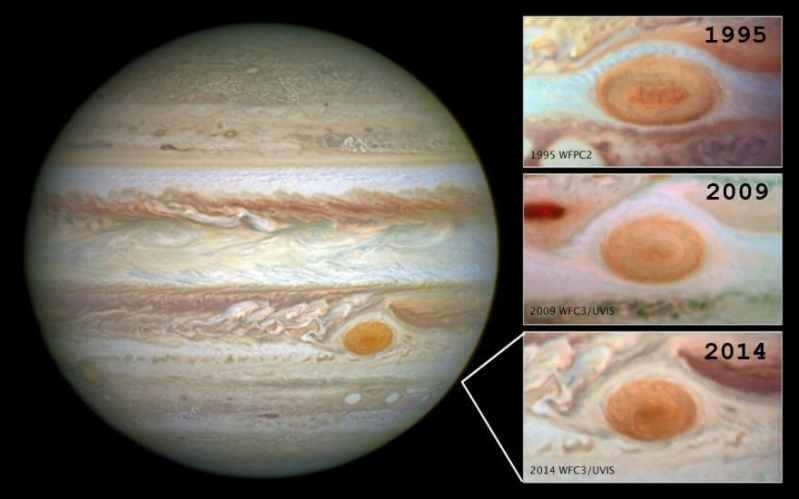
Jupiter’s Great Red Spot, which is associated with the planet Jupiter, has been captured in images taken by the Hubble Space Telescope for a period of 20 years. The images reveal a decrease in the size of the spot in recent years.
The Great Red Spot is an anticyclonic storm that rotates at a speed of 22°. Scientists believe that the storm’s darker red color is a result of sulfur and ammonia particles found deep in Jupiter’s atmosphere. These particles darken and lighten as they come into contact with sunlight. While there are smaller storms on Jupiter, they are usually white and become darker as their volume increases.
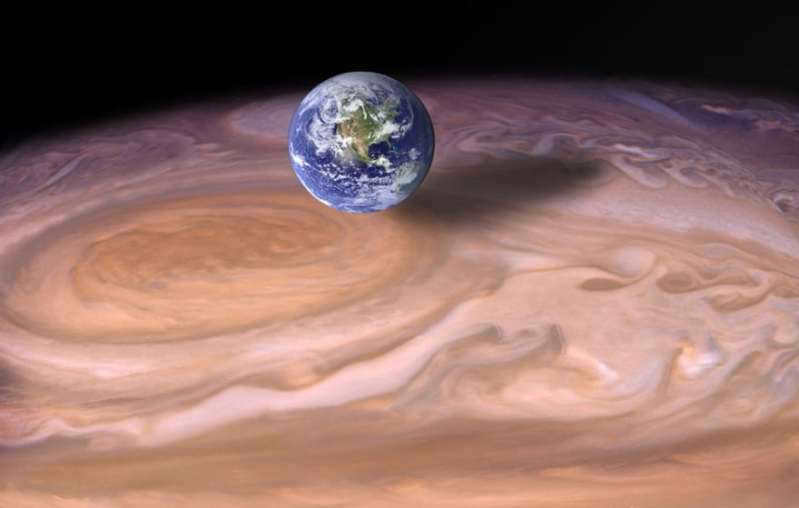
What is the big red spot and which planet is it connected to?
Scientists are still unable to determine if this occurrence is temporary or permanent. However, it was already present when Jupiter was observed in the 1600s. Presently, they observe that its dimensions are diminishing, but it persists.
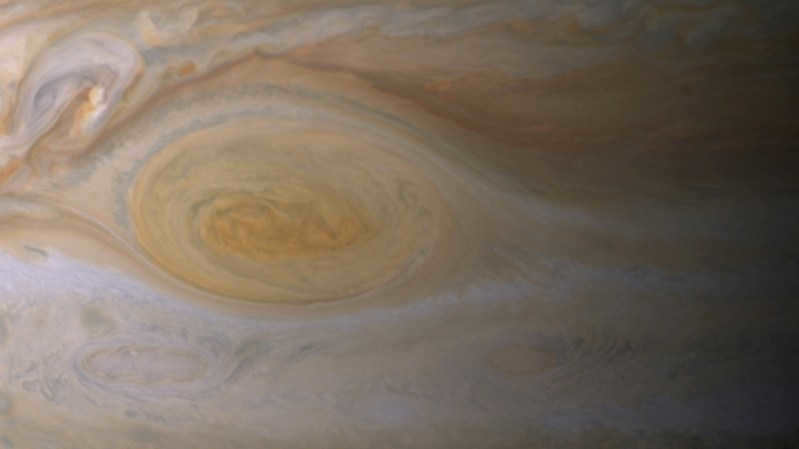
The Great Red Spot on Jupiter, along with several smaller spots, is the only place where the intense red color can be seen. Scientists believe that the spot’s location in the upper layers of the atmosphere and its high altitude are key factors in its vibrant hue, as it reaches heights that surpass those of clouds found elsewhere on the planet.
Measuring a staggering 24,000 km by 12,000 km, the Great Red Spot is a massive feature on Jupiter. In fact, it could easily accommodate 2-3 Earths within its boundaries. Additionally, the edge of the spot spins at a remarkable speed of 360 km/h and rises 8 km above the surrounding clouds.
If the current trend of shrinkage continues, the Great Red Spot is projected to become nearly circular by the year 2040 and eventually vanish altogether. Now you have a better understanding of the fascinating phenomenon that is the Great Red Spot on Jupiter.
The Great Red Spot is an enormous vortex that has been raging in the atmosphere of Jupiter for hundreds of years. This vortex is of such immense proportions that it is hailed as the largest atmospheric vortex in the entire solar system. To put its size into perspective, it is mind-boggling to imagine that three Earth-sized planets could fit snugly within Jupiter’s Great Red Spot.
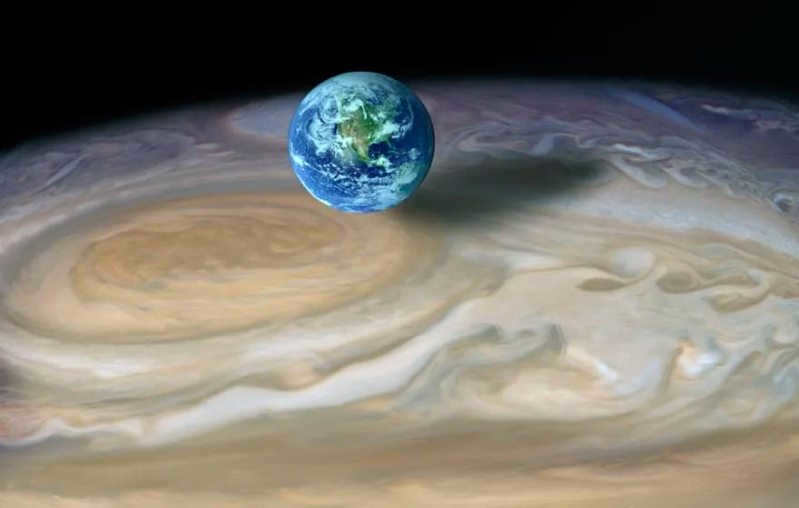
A comparison of the sizes of Earth and Jupiter’s Great Red Spot.
What is the Great Red Spot?
When observations first began, the Red Spot had a length of approximately 40,000 kilometers and a width of 13,000 kilometers. Over time, its size has gradually decreased: in 1979, it measured 23,300 kilometers, and by 2014, it had reduced to 16,500 kilometers. The winds within the storm reach speeds exceeding 500 kilometers per hour.
It is believed that the observation of a storm on Jupiter by Giovanni Cassini in 1665 was the first time it was recorded, but since no permanent records were kept until at least 1830, it is possible that the “old” and “new” spot are similar, but different. In any case, the Great Red Spot is currently between 180 and 350 years old. Not bad for an atmospheric phenomenon?
The Pioneer 10 spacecraft was the first to photograph Jupiter’s Great Red Spot up close in 1973, followed by Voyager 1 in 1979. Both Voyager 1 and Voyager 2 captured images of the spot. In 1995, the space probe “Galileo Galilei” was launched into Jupiter’s orbit. Galileo and in 2007, the New Horizons spacecraft approached Jupiter. New Horizons.
An animation composed of photographs of Jupiter’s atmosphere provides a fascinating glimpse into the movement of the iconic red spot on the planet’s surface.
What accounts for the remarkable size and enduring lifespan of Jupiter’s prominent red spot?
It is worth noting that while the Great Red Spot is the most renowned long-term storm on Jupiter, it is not the only one. Other “hurricane spots” can exhibit various colors such as white, brown, and red, and can persist for decades. These atmospheric spots can be found in both the Southern and Northern hemispheres of Jupiter, but for some unknown reason, only the Southern hemisphere seems to host stable, long-lasting ones.
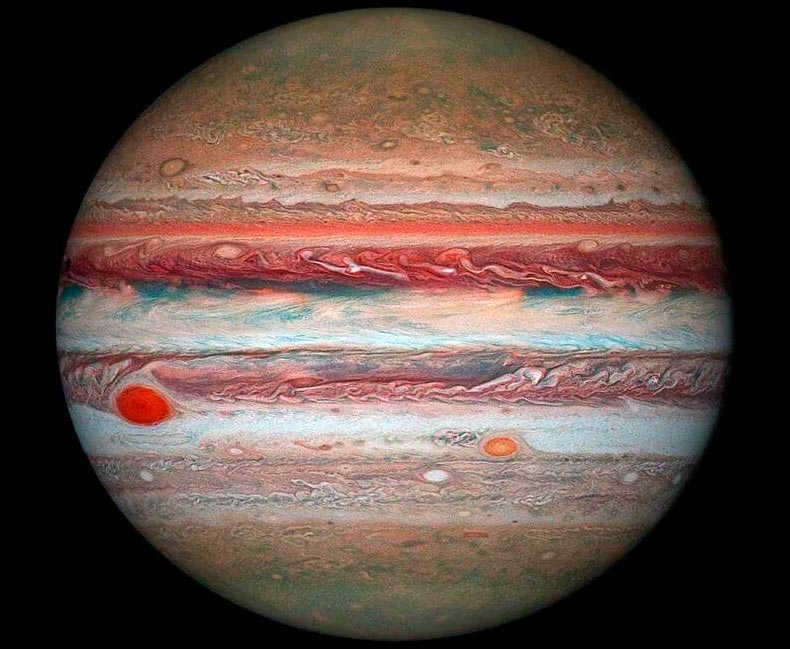
Indeed, the giant storm known as Jupiter’s red spot is not the sole tempestuous feature adorning the surface of this planet (located to the left, just below the equator). If one observes closely, they will readily discover additional white, brown, and other similar “spots” of slightly smaller dimensions. Each of these atmospheric vortices can be classified as distinctly Jupiterian in nature.
Computer simulations indicate that the persistence of such atmospheric phenomena is a prevalent occurrence on Jupiter, and that more powerful hurricanes are capable of assimilating weaker ones. It is highly probable that the great red spot achieved its vast proportions through the process of absorption by other hurricanes.
Giant “hurricane spots” can be found not only on Jupiter, but also on other gas planets. One well-known example is the Great Dark Spot on Neptune.
“Juno” Explores the Depths of the Great Red Spot
Planetologists from the team of the interplanetary spacecraft “Juno” have shared their findings on the three volumetric structures of Jupiter’s vortices – a cyclone and two anticyclones, including the Great Red Spot. Their research revealed that the famous anticyclone extends much deeper into the atmosphere than previously believed. Additionally, the other two vortices reach below the level of water vapor condensation, which challenges current models of the gas giant’s atmospheric structure. The findings have been published in the journal Science (1, 2).
The team of planetologists, led by Marzia Parisi from NASA’s Jet Propulsion Laboratory, has released new findings based on the Juno data. By analyzing gravity measurements, they were able to ascertain the depth of the Great Red Spot, which is the largest anticyclone in our solar system and has been observed on Jupiter for over 300 years. Previous estimations, derived from data collected by the MWR instrument, suggested a depth of approximately 240 kilometers. However, the team’s latest research indicates much larger estimates, ranging from 200 to 500 kilometers.
Scott Bolton, from the Southwest Research Institute, led a different team of planetologists who examined data from the microwave radiometer on the spacecraft. They were able to study the structure of three atmospheric vortices, including the famous Great Red Spot, as the spacecraft approached Jupiter. The team confirmed the previous findings that the Great Red Spot extends no more than 500 kilometers into the atmosphere.
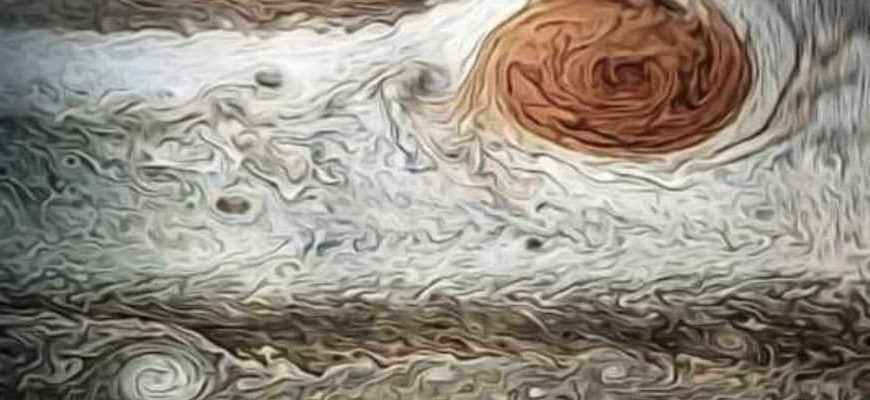
One of Jupiter’s most iconic features is the Great Red Spot, a colossal storm that roams through the planet’s atmosphere like a gigantic wandering eye. This renowned tempest is shrouded in numerous enigmas, some of which have been unraveled, while others remain a mystery.
This enormous object is simply a anticyclonic storm. What makes it even more fascinating is that it is rotating in the opposite direction of Jupiter’s powerful winds. To those observing Jupiter from Earth, it may appear as if the BKP is being pushed against the flow of Jupiter’s atmosphere. It’s like someone trying to get closer to the stage at a packed concert by Olga Buzova😁.
However, the largest planet in our solar system doesn’t actually have an epic storm battle happening. The BKP is actually an anticyclone, which means it moves independently from the rest of Jupiter’s weather patterns.
Scientists have established with a high degree of confidence that the storm on Jupiter is elevated compared to the other clouds on the planet. It is approximately 8 kilometers higher. Notably, however, a significant portion of the storm exhibits cooler temperatures than the surrounding weather conditions. However, in 2017, scientists obtained some surprising data which revealed that the highest point of the storm, situated near the upper atmosphere of Jupiter, is remarkably hot. This revelation completely challenged the prevailing understanding of the nature of the BKP.
The estimated speed at which the giant anticyclone moves through the atmosphere of Jupiter is 650 kilometers per hour. This value can be compared to the maximum speeds of hurricanes on Earth, such as Hurricane Maria, which reaches a maximum speed of 280 kilometers per hour.
However, BKP is not the only high-speed hurricane on Jupiter. Another lesser-known anticyclone called the Little Red Spot also exists. Although smaller in size, it also moves at a high speed.
That’s an excellent question. One that is currently unknown to NASA, ESA, and even Dmitry Rogozin. Certain investigations propose that the hue of the BKP is influenced by the presence of ammonia, ammonium hydrosulfide, and water. All of these elements are present in the upper atmosphere of Jupiter. However, does this theory hold true? No, scientists are not entirely certain. This is because these chemicals, which constitute a small proportion of the atmosphere’s makeup, are incapable of independently generating an entity as massive as Jupiter’s Great Red Spot.
Given that traveling to Jupiter is quite challenging, scientists are currently engaged in developing scaled-down versions of BKP here on Earth. They carefully combine the appropriate quantities of chemicals and ensure the correct levels of light and radiation. However, achieving the precise color has proven elusive thus far.
What is the age of the Great Red Spot?
As of now, there is no definitive answer to this query. Roughly 50 years following Jupiter gaining widespread recognition in Europe, a polymath from Britain named Robert Hooke unexpectedly developed an interest in astronomy. It was he who initially observed storms on the planet, back in 1664. The subsequent year, the renowned Italian astronomer Giovanni Cassini witnessed the phenomenon and provided a description. Consequently, Cassini is recognized as the discoverer of BKP.
What does the future hold for the Great Red Spot?
The question at hand is not a simple one. In recent times, a number of observers have noticed a decrease in the size of the Great Red Spot. Could it eventually vanish entirely? While that is a possibility, it is not very likely.
Scientists have observed that the tempest utilizes the smaller tempests it encounters as a source of sustenance. (Consider this: what if the Great Red Spot is a colossal extraterrestrial organism that resides within Jupiter’s atmosphere?!).
All in all, there are more queries than answers… Currently, it is impossible to definitively ascertain what is occurring within the Great Red Spot. Nevertheless, this won’t deter scientists from pursuing the truth.
This location bears a resemblance to Jupiter’s enormous purple eye that gazes upon the surrounding world. It spans 25,000 kilometers in diameter, which is large enough to engulf a couple of planets similar to our own. However, the size of this sunspot is not constant; it possesses a mysterious existence of its own. It expands across the planet before eventually contracting again. When it was first observed in detail in 1878, it was twice as large as its current size.
Previously, Jupiter was believed to be a solid planet akin to Earth. The red spot appeared to scientists as a massive lake of red-hot magma flowing across the planet’s surface. Air currents originating from the spot dispersed the clouds, allowing us to glimpse its outline through the veil. Some theorized that amidst the ocean overflowing Jupiter, there existed a brick-red continent.
In this region of Jupiter, there are distinct boundaries created by the surrounding air currents. The prevailing winds blow in a westward direction from the north and in an eastward direction from the south. The Great Red Spot is situated between these two currents, and it has remained in this position for a hundred years, much like a star fixed in the sky. However, over time, it has gradually shifted in a latitudinal direction (from east to west), causing the storm to impact new areas of the planet.
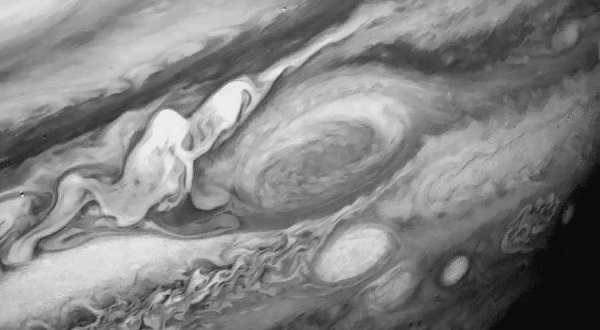
The enormous crimson eye of Jupiter, known as the Great Red Spot, gazes upon the world around it.
In recent times, other smaller spots have been discovered on Jupiter (although even these “little fellas” are as large as the Earth).
For instance, in 2006, the Hubble Space Telescope observed that the “White Oval” (a storm that has been raging on Jupiter since 1998) underwent a six-month transformation in color. In November 2005, it remained white, but a month later, hints of brown began to emerge, and by July 2006, it matched the exact hue of the Great Red Spot. We may be witnessing the emergence of a “Lesser Red Spot” on this celestial body.
What caused the formation of the Great Red Spot? How is it structured? In early 2010, the European Southern Observatory’s Very Large Telescope (VLT) managed to peer deep into the depths of the Great Red Spot for the very first time. Prior to this, it was believed that the air masses comprising the Great Red Spot only rotated in a counterclockwise direction. However, the recently captured photographs, with unprecedented clarity, reveal previously unknown features of this phenomenon. It turns out that the air masses are not simply moving in one consistent direction. On the contrary, the central region of the spot actually rotates in a clockwise manner, while all other parts of the spot continue to rotate counterclockwise.
However, the primary enigma of this atmospheric whirlwind remains unresolved. The source of the brownish-red hue of the spot is still uncertain. Various hypotheses have been proposed. It is possible that molecules of a certain substance in Jupiter’s atmosphere undergo decomposition due to lightning or ultraviolet radiation, resulting in the release of phosphorus. Another hypothesis suggests that the vortex draws organic matter, phosphorus, or sulfur from the depths of Jupiter, causing them to rise to the upper atmosphere and give the Great Spot its unique coloration. What is clear is that the spot’s color changes over time, exhibiting various shades.
Perhaps the enigmas surrounding the Great Red Spot will be unraveled by a new interplanetary probe, set to reach Jupiter within this decade. There is much to be discovered. Numerous uncertainties remain regarding the very genesis of this colossal planet.
However, there are significant contradictions in this hypothesis, as has become evident. Calculations indicate that the development of a massive celestial body such as Jupiter requires a minimum of 10 million years. Nevertheless, recent observations of protoplanetary disks situated near other stars resembling our Sun have revealed that once a thermonuclear reaction ignites within the core of a nascent star, the hydrogen stores necessary for the formation of a colossal planet are rapidly depleted. Nevertheless, Jupiter somehow managed to expand to its present dimensions. How did this occur?
This is a brief introduction.
Additional Information
Red Banner Order
The Red Banner Order, also known as the Combat Red Banner, is the oldest order of the Soviet Union. It was created on August 1, 1924. The predecessor to this order is the Red Banner Order of the RSFSR.
THE VICTIMS OF THE RED TERROR Terror is an act of cruel violence carried out by individuals who themselves feel fear. Engels In this essay, we will not discuss the executions of individuals, but rather the complete state policy of eradicating social classes. Human society
VICTIMS OF THE RED TERROR
VICTIMS OF THE RED TERROR It is widely believed that the Red Terror was a reaction to the White Terror, which refers to the terrorist attacks by bourgeois elements against the Communists. However, in reality, the Red Terror began with the Bolshevik seizure of power.
The sight of the night sky, adorned with twinkling stars, captivates any individual whose spirit is still lively and not completely jaded. The enigmatic vastness of Eternity unfolds before the awestruck human gaze, prompting deep contemplation.
Scarlet Cadet Lane
Scarlet Cadet Lane A petite pathway connects Scarlet Cadet Street and Little Grebetskaya Street. In the 1849 plan, it was referred to as Musician’s Lane, just like the adjacent lane that still bears the same name. However, on April 16, 1887, it was renamed Cadet Lane. Across from the lane, on the side with odd numbers,
There is a small alleyway that connects Red Cursant Street and Malaya Grebetskaya Street. Originally, on a 1849 map, it was named Musikantsky, along with the neighboring lane that still bears that name. However, on April 16, 1887, it was changed to Yunkersky. Across from the lane, on the odd-numbered side, is
RED CADET STREET
RED CURSANT’S STREET Red Cursant’s Street stretches from Bolshoi Prospect on the Petrograd side to a dead end behind Gdovskaya Street. In 1738, the Commission on St. Petersburg construction decided to give the section of the street from present-day Bolshoi Prospect to Muzykantsky Street the name Red Cursant’s Street.
The enigma of the Big Bang has captivated the minds of scientists and theologians for centuries. They have long pondered the origins of our world, each offering their own unique explanation. Despite their divergent perspectives, both groups have shared a common belief in the static and immutable nature of the Universe. However, recent discoveries challenge this long-held assumption.
Bathing a red horse. 1912. The painting titled “The Bathing of the Red Horse” is widely recognized as one of the most renowned and enigmatic artworks of the early 20th century. It seamlessly blends elements of iconography, featuring the iconic figure of St. George the Victorious, with the avant-garde aesthetic of modernism. Art critics have long been captivated by its captivating allure and profound mystery.
Removing red wine stains
Eliminating red wine stains requires a calm and composed approach. Firstly, it is crucial not to panic when faced with a wine stain. Such stains are often an inevitable part of hosting a successful gathering, whether it be at home or elsewhere. They serve as mementos of the joyous occasion. Instead of becoming overly concerned, it is advisable to refrain from requesting that guests remove their shoes upon entering and awkwardly arranging themselves.

